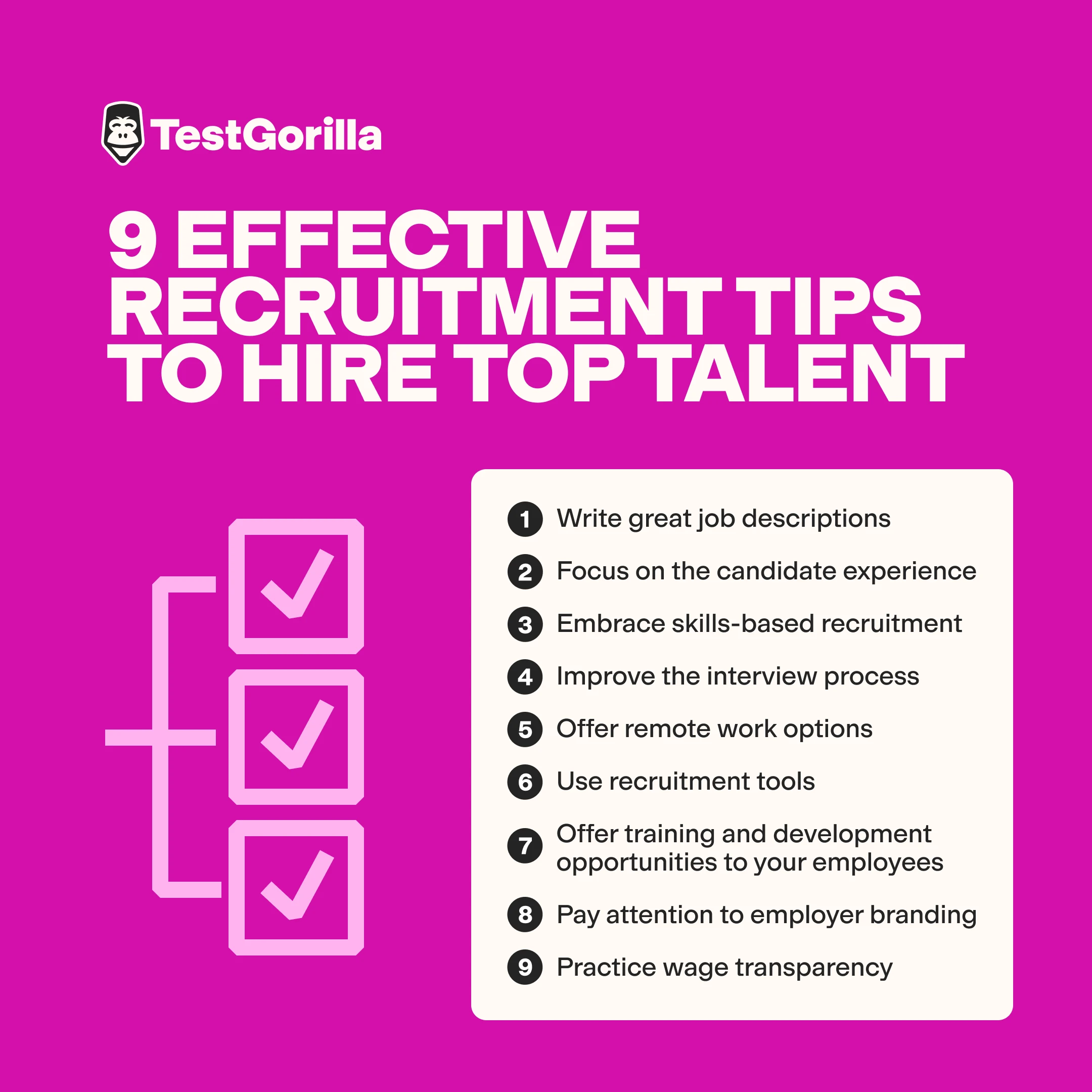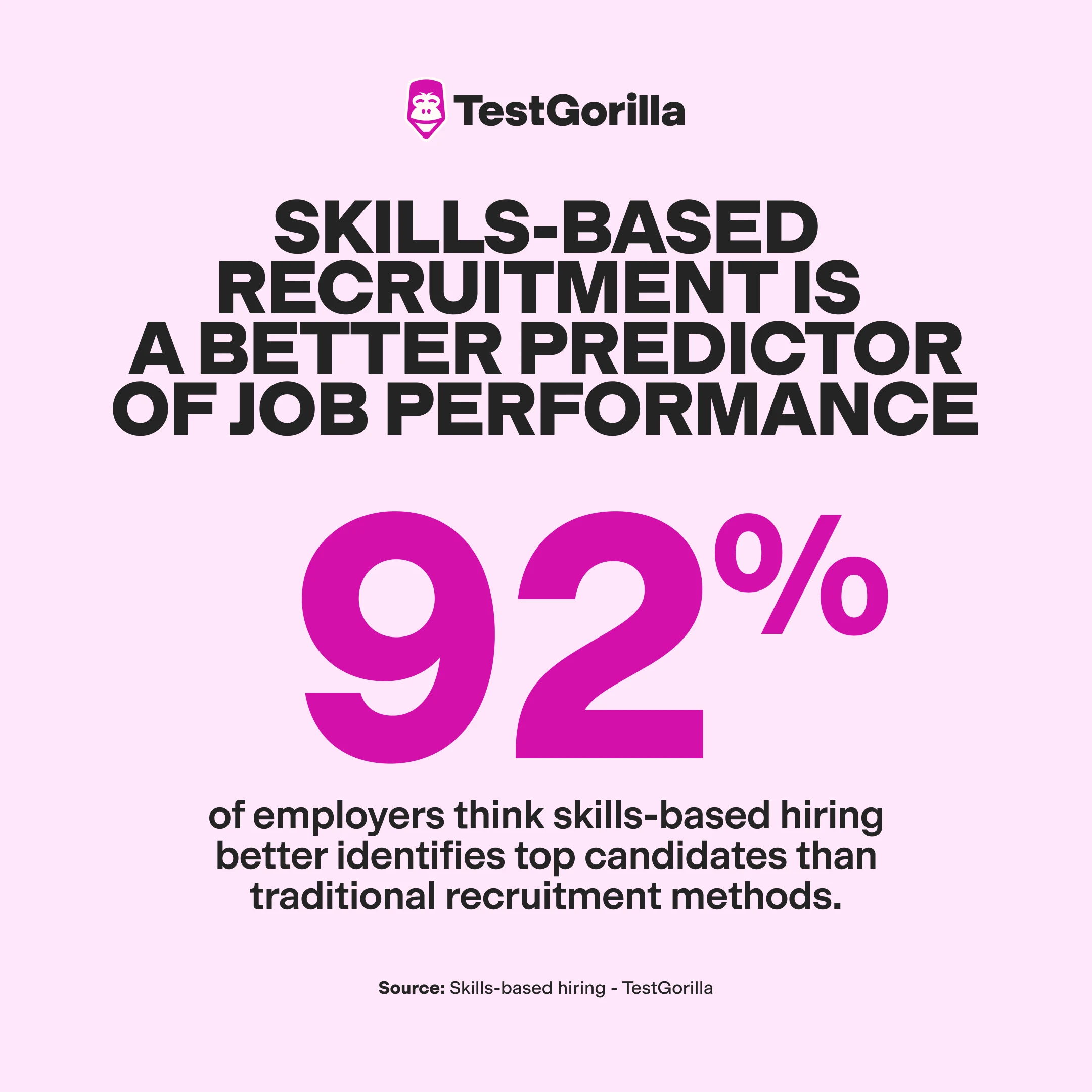From zero to hiring hero: 9 recruitment tips to hire better talent
Use talent assessments to hire better candidates
Many companies have developed new strategies to attract and hire the best candidates. As a result, snatching up great talent is harder than ever.
Every rejection and each candidate lost to a competing offer leads to delayed hiring timelines and worse recruitment outcomes that hinder your business’ potential growth.
That’s why we discuss how to recruit using talent assessments and explore recruitment tips for hiring managers to help you find the best talent.
9 effective recruitment tips to hire top talent
With the rapid development of technology and the increased popularity of remote work in the past few years, it’s clear that you need to change your hiring approach to attract more candidates.
Here is a list of the latest recruiting tips and tricks you can use to develop a clear and efficient hiring strategy:
The summary of the most effective recruitment tips for hiring managers
How to recruit people the right way | Benefits |
1. Write great job descriptions | Attract suitable applicants while filtering out unqualified ones |
2. Focus on the candidate experience | Achieve higher offer acceptance rates and build a stronger employer brand |
3. Embrace skills-based recruitment | Reduce chances of mis-hires, shorten time-to-hire, and lower hiring costs |
4. Improve the interview process | Ensure a better candidate experience and select the best talent for your team |
5. Offer remote work options | Attract a more diverse pool of top talent |
6. Use recruitment tools | Automate tasks, improve communication, and provide data-driven insights |
7. Offer training and development opportunities to your employees | Increase employee satisfaction and keep your business competitive |
8. Pay attention to employer branding | Attract more candidates and achieve higher employee retention rates |
9. Practice wage transparency | Build trust, attract quality candidates, and reduce turnover |
1. Write great job descriptions
Job descriptions are crucial for talent acquisition because they give potential new hires their first impression of the role and the company.
According to a survey by Indeed, 52% of candidates think the quality of job descriptions is important in their decision to apply for a role during their job search.
Effective descriptions clarify expectations and responsibilities while showing your company’s culture and values. They help you attract suitable applicants and filter out unqualified ones.
Here are some hiring tips for managers on how to write better job descriptions:
Be specific: Clearly define responsibilities, qualifications, and key skills required for the role. For example, if you’re seeking an iOS developer, specify the programming languages and frameworks needed and necessary soft skills like communication and time management.
Structure the job description: Place key information at the top, including essential responsibilities, required skills, benefits, and work conditions. Candidates should immediately understand if the role suits them.
Be concise: Use bullet points for qualifications and responsibilities and keep the overall text brief. According to a LinkedIn study, job descriptions shorter than 300 words attract an average of 8.4% more applicants.
Watch your wording: Avoid jargon that could confuse candidates and gendered or exclusive terms. Instead, use neutral language that appeals to a broad audience. For example, instead of “salesman,” use “sales representative” or “salesperson.”
Show your company’s culture: Provide a glimpse of the team dynamic or remote work flexibility to differentiate yourself from competitors.
2. Focus on the candidate experience
Candidate experience refers to how candidates perceive your company throughout the hiring process, from initial contact to the final decision. That’s important because 52% of job seekers report declining an offer due to a poor experience during the hiring process.
Creating a positive experience shows that your company values and appreciates its employees, making the right candidates more likely to accept offers and advocate for your brand.
Here are some hiring tips for managers looking to improve the candidate experience:
Keep candidates informed about their application status and timelines to reduce uncertainty
If an interview process includes multiple stages, give candidates a clear overview of the process
Manage interview scheduling and avoid delays
Provide tailored feedback and recognize applicants’ unique skills to make them feel needed
Focus on candidates’ skills, values, and motivations
Share your company culture and values throughout the recruitment journey to help applicants envision themselves as part of the team
3. Embrace skills-based recruitment
Degrees or skills – which are more important?
We say skills because they are a better predictor of job performance. In fact, 92% of employers think skills-based hiring better identifies top candidates than traditional recruitment methods.
Hiring managers try to keep up with the times and search for ways to objectively evaluate the skills needed for the job.
But how do you determine which skills you should be looking for? And how to recruit people with those skills?
One way to develop a data-driven hiring strategy is using skill assessments in the recruitment process.
Skill assessments are standardized tests that evaluate candidates’ capabilities and how well they can perform certain tasks. You can use them to test job applicants and discover whether they have the necessary competencies for the role.
For example, if you need a project manager to tackle more client work, you can use our Project Management test to assess candidates’ ability to manage projects effectively.
This test focuses on risk management, stakeholder communication, and project planning competencies to help identify candidates with the skills required for the role.
You can then compare results and ensure that your next hire has the skills to excel at managing projects.
Use our skills tests to improve your recruitment strategy
Skills tests help you hire objectively and without bias. Sign up for a free demo with TestGorilla to learn more about how to use skills assessments in your hiring process.
4. Improve the interview process
According to a survey conducted by Yello, recruiters spend 67% of their time on the interview process.
A good interview improves the candidate experience and identifies the right talent for your team. In contrast, unstructured interviews can turn candidates away, even if the role is a perfect match.
How do you ensure your candidates are comfortable when answering interview questions and have the best possible experience?
These hiring tips for recruiting can help:
Use structured interviews to compare potential candidates fairly
Incorporate practical tasks or skill assessments relevant to the job to help you gauge candidates’ actual abilities
Train interviewers in active listening, unconscious bias reduction, and behavior-based questioning
Limit interviews to a few stages and provide a clear outline of the process, including the number of interviews, their purpose, and the timeline
Consider video interviews or one-way video screenings instead of in-person interviews to help the candidates feel more secure and confident by interviewing in a familiar environment and reducing travel stress
5. Offer remote work options
Remote work is here to stay. According to McKinsey’s American Opportunity Survey, 58% of US workers can do their job remotely at least one day a week. Furthermore, when they have the opportunity to do so, 87% of them take it.
Remote work gives human resources more flexibility and control over their work environment and reduces their commuting expenses. At the same time, it’s beneficial for companies because the best applicants for the open positions could be in an inconvenient location.
Businesses are also beginning to realize the perks of working remotely, including:
Reduced costs
Less stressed employees due to a lack of daily commute
Increased productivity
More automated processes
Although remote work provides numerous benefits, some employers are concerned that it can cause productivity dips, difficulties maintaining strong team collaboration, and data security problems.
However, with the right strategies in place, you don’t have to worry about these. Instead, develop a remote work policy that focuses on:
Setting clear expectations: Define working hours, communication protocols, and deadlines upfront to maintain productivity and accountability
Using collaboration tools: Use remote work software, video conferencing, and chat apps to keep everyone connected and in sync
Embracing work-life balance: Encourage regular breaks and establish boundaries between work and personal time
Providing training: Offer training on effective remote work strategies and technology use to help new employees stay productive
Supporting inclusivity: Create virtual team-building activities to maintain a strong company culture
6. Use recruitment tools
Recruitment tools streamline hiring by automating repetitive tasks, improving communication, and providing data-driven insights. They help companies manage candidate sourcing, screening, and onboarding efficiently while reducing bias.
Applicant tracking systems (ATS) are among the most popular options because 78.3% of hiring managers think this tool has helped them hire qualified candidates.
Another big trend in recruitment efforts is using AI to recognize and predict patterns.
Recognizing and analyzing patterns objectively is vital for any hiring manager or recruiter. That’s why you can use AI-driven tools to:
Scan sourcing platforms for potential employees
Screen new candidates
Optimize job descriptions to attract suitable candidates
Organize databases
Improve branding
Improve the onboarding process
Using AI for hiring has certain benefits and drawbacks:
Pros: | Cons |
Shorter time to hire Reduced hiring costs Better communication Improved candidate experience | Accuracy issues Lack of nuance in judgment Privacy concerns |
Use TestGorilla to enhance your recruitment efforts
Our talent assessments help you lower costs, reduce time to hire, and boost the quality of hire without the drawbacks of AI. Sign up for your free account to get started with skills-based hiring today.
7. Offer training and development opportunities to your employees
Finding growth opportunities for your current employees and providing them with the resources to develop job-related skills can keep them happy and help your business grow.
Answer the following questions to start building a strategy to make that happen:
What are your organization’s objectives?
Which critical roles can help your company meet these objectives?
What skills are crucial for these roles?
What level of proficiency do you need for these roles?
How can you upskill your employees so that they can reach this level?
Investing in learning and development opportunities can make your employees’ connection to your organization more authentic and rewarding.
Finding the right people for the job is great, but investing in their growth is even more rewarding.
To achieve that:
Analyze current ability levels to identify skill gaps
Provide courses, workshops, or mentorship programs tailored to upskill employees in key areas
Collaborate with employees to set personalized growth goals and track progress
Recognize and reward employees who actively develop their skills and contribute to organizational success
8. Pay attention to employer branding
Sourcing candidates is one of the first steps in the long journey toward finding the right employee for your organization. A strong brand can attract great candidates to your business and make top talent more open to a job offer from your company.
A Glassdoor survey found that 69% of active job seekers are likely to apply for a role if the employer manages its employer brand actively.
Passive candidates who are open to opportunities but aren’t currently seeking a new job are more likely to notice your company if it has a well-developed brand, which reduces the time you have to spend actively recruiting people.
Focusing on developing your employer brand has many other benefits:
Reduces staff turnover and retains your present employees
Saves the time and additional costs of defining your organization’s brand individually for every candidate
Attracts more people who are a good culture add to your business
9. Practice wage transparency
Nowadays, workers want to see wage rates in job postings. In fact, 67% of applicants consider salary the most important factor when reviewing a job description.
Wage transparency helps you build trust, attract quality candidates, and reduce turnover by aligning expectations from the initial point.
Here are some tips for recruitment that can help you embrace wage transparency:
Consider the types of applicants you want to hire
Search for unbiased compensation data based on factors such as supply and demand and wage inflation
Make your job postings efficient by advertising competitive wages
Create consistent guidelines for salary negotiations to prevent bias and inequity
Regularly conduct pay equity audits to identify and address wage gaps
Build a better recruitment process with talent assessments
Talent assessments help companies make informed hiring decisions by identifying candidates with the right skills for a given role. Using these tests reduces bias and ensures a better match between applicants and job requirements.
For example, Orbit Technologies, a global semiconductor services provider, needed help finding competent candidates. The company struggled with mis-hires and instant attrition, so it used TestGorilla to turn things around.
Using a combination of personality, cognitive ability, and technical skills tests helped the organization hire better candidates and reduce instant attrition rates by 50%.
Here’s how it works in real life.
Let’s say you need an addition to your marketing team to handle LinkedIn advertising for your new clients. You can use our LinkedIn Advertising test to evaluate how good the candidates are at creating strategies, managing campaigns, targeting the right audience, and analyzing and optimizing strategies.
By comparing your candidates' results, you can find the best digital marketing professional for your business.
If you want to see more questions from this test, take a look at the LinkedIn Advertising test preview.
The best insights on HR and recruitment, delivered to your inbox.
Biweekly updates. No spam. Unsubscribe any time.
Hire better talent with TestGorilla
Understanding the current economic landscape, hiring trends, and recruiting tips and tricks can help you optimize your hiring process.
Recruitment tips for hiring managers can’t guarantee a 100% success rate, but skills assessments, data-driven recruitment, and employer branding can help you find and retain the most suitable candidates for your business.
Take a product tour to discover how talent assessments work.
Sign up for a live demo to explore all the benefits these skills tests can bring to your recruitment strategy.
Sign up for a free forever plan to streamline hiring and make the right recruitment choices.
Tips for recruitment FAQs
We’re saving the best for last. Here are a few more recruiting tips and tricks you can use to find the best candidates for your company.
What is the most effective method of recruitment?
Direct advertising through job boards and online ads
Employee referrals for trusted candidates
Social media recruiting on platforms like LinkedIn
Talent pool development
Boomerang employees
Employer branding
Promotions and internal mobility
Recruitment agencies for specialized talent
Internships and apprenticeships
Job fairs to meet the candidates directly
How do you stand out as a recruiter?
Prioritize building genuine relationships with candidates
Maintain clear, consistent communication throughout the hiring process
Focus on what makes your company unique and how it can help applicants develop their careers
Remember small details from candidate interactions
Include personalized touches in your communication
Use technology and recruitment tools to improve hiring efficiency and candidate experience
Provide constructive feedback to all candidates
How can I make my recruiting better?
Write better job descriptions
Use skills-based assessments to identify the right talent
Streamline the interview process for efficiency
Prioritize candidate experience by providing clear communication
Strengthen your employer brand to attract top candidates
Use recruitment tools for effective screening and onboarding
Regularly analyze recruitment data to refine your strategy
Ignore unproductive recruitment tips and focus on what works
Related posts
You've scrolled this far
Why not try TestGorilla for free, and see what happens when you put skills first.





















